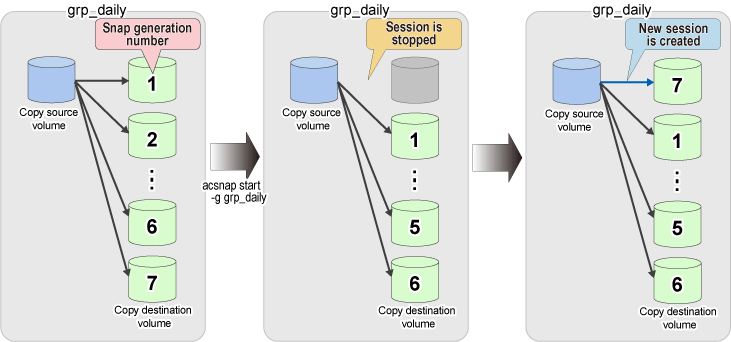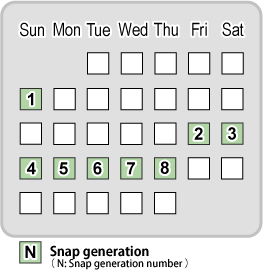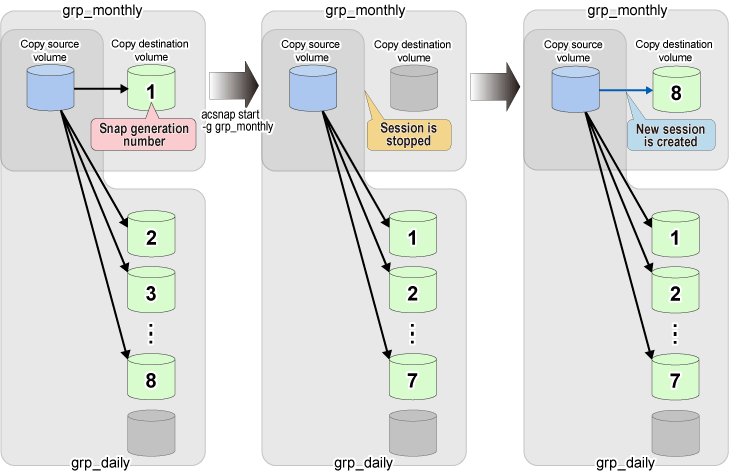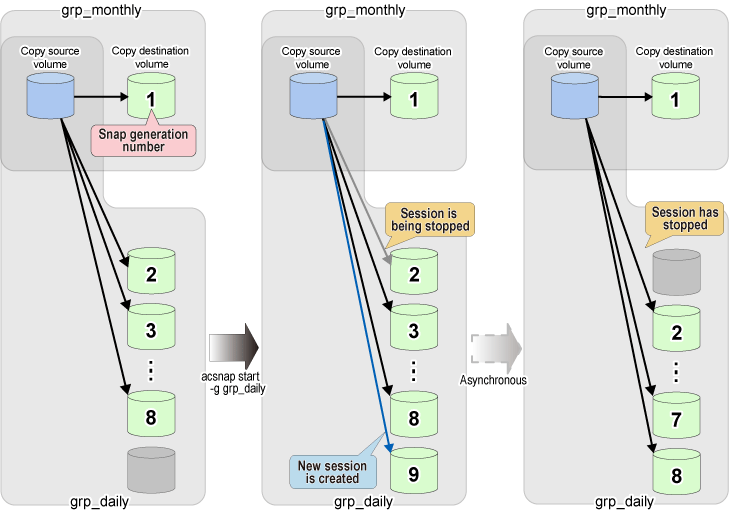This section describes how to manage snap generations automatically, using the following two examples.
Point
The method of generation management varies depending on the value set for the required number of free volumes. Refer to "2.6.2 Logic for Selection of Copy Pair to Start SnapOPC+" for details.
Management of Seven Generations with Daily Backup

To manage seven generations of daily backups, create seven copy pairs for a single copy group. In this case, the required number of free volumes does not need to be set.
Snap generations can be managed automatically when the acsnap start command is executed by specifying a copy group. For information on how to perform a backup, refer to "3.2.1.5 Backup via SnapOPC+".
The following is an overview and example of a command execution when the name of the copy group is "grp_daily".
Frequency of Execution | Command Execution Example | Overview of Command Executions |
|---|---|---|
Once a day | acsnap start -g grp_daily |
|
Figure 2.1 Processing of "acsnap start" Command for "grp_daily" Copy Group

When the acsnap start command is executed, the snap generation numbers are moved up by one when the SnapOPC+ session of the oldest snap generation in the copy group is stopped (in the example above, the numbers from "2" to "7" in the left figure are moved up to "1" to "6" in the center figure). After that, a new SnapOPC+ session is set for the volume whose SnapOPC+ session was stopped and the latest snap generation number is allocated to that volume (in the example above, "7" in the right figure).
Management of One Generation with Monthly Backup and Seven Generations with Daily Backup

Information
In the above figure, snap generation number "1" is retrieved from the monthly backup and snap generation number "2" to "8" are retrieved from the daily backup.
To manage one generation of monthly backups and seven generations of daily backups, two copy groups are required.
Create a copy pair in the copy group for the monthly backup. For this copy group, settings for the required number of free volumes are not necessary.
Create eight copy pairs in the copy group for the daily backup. For this copy group, settings for the required number of free volumes are necessary.
When the name of the copy group for monthly backup is "grp_monthly" and the name of the copy group for daily backup is "grp_daily", the required number of free volumes and copy pairs are as follows.
Purpose of the Copy Group | Required Number of Free Volumes | Required Number of Copy Pairs |
|---|---|---|
Monthly backup | 0 (setting not necessary) | 1 |
Daily backup | 1 | 8 (= 7 + Required number of free volumes) |
Snap generations can be managed automatically by executing the acsnap start command for each copy group as described below. For information on how to perform a backup, refer to "3.2.1.5 Backup via SnapOPC+".
The following is an overview and example of a command execution when the name of the copy group for the monthly backup is "grp_monthly" and the name of the copy group for the daily backup is "grp_daily".
Frequency of Execution | Command Execution Example | Overview of Command Executions |
|---|---|---|
Once a month | acsnap start -g grp_monthly |
|
Once a day | acsnap start -g grp_daily |
|
Figure 2.2 Processing of "acsnap start" Command for "grp_monthly" Copy Group

When the acsnap start command is executed for copy group "grp_monthly", the snap generation numbers for "grp_daily" are moved up by one when the SnapOPC+ session for copy group "grp_monthly" is stopped. (In the example above, the numbers from "2" to "8" in the left figure are moved up to "1" to "7" in the center figure.)
After that, a new SnapOPC+ session is set for the free volume of the copy group "grp_monthly" and the latest snap generation is allocated to that volume. (In the example above, "8" in the right figure.)
Figure 2.3 Processing of "acsnap start" Command for "grp_daily" Copy Group

When the acsnap start command is executed for copy group "grp_daily", the SnapOPC+ session of the oldest snap generation (in the example above, "2" in the left figure) is stopped in copy group "grp_daily". However, because this snap generation is not the oldest one in the copy source volume, deletion of the SnapOPC+ session may take time. Since a new snap generation cannot be retrieved for a copy pair which already has a SnapOPC+ session, SnapOPC+ is started in a free volume prepared in the settings for the required number of free volumes (in the example above, the volume for which a generation number is not allocated). A new SnapOPC+ session is started while the old SnapOPC+ session is being deleted, so there temporarily is eight generations (in the example above, "2" to "9" in the center figure).
A SnapOPC+ session in the process of being deleted is deleted automatically as time passes. When the SnapOPC+ session is deleted, the snap generation numbers for the copy group "grp_daily" are moved up by one (in the example above, the numbers from "3" to "9" in the center figure are moved up to "2" to "8" in the right figure). The volume of the copy pair used by the stopped SnapOPC+ session is used as a free volume when the next snap generation is retrieved.
Point
When generation management is performed for multiple copy groups in one copy source volume, the oldest snap generation in the copy group targeted for processing may not be the oldest snap generation in the copy source volume. When a snap generation other than the oldest in the copy source volume is deleted, the SnapOPC+ session that is being deleted may remain for some time after the command is returned.
The next snap generation cannot be retrieved for copy pairs of SnapOPC+ sessions whose stoppage process is yet to be completed. To delete a snap generation other than the oldest, configure one or more volumes for the required number of free volumes to make sure that at least one free volume is always available.
If stoppage of a SnapOPC+ session may not be completed in time to retrieve the next backup due to the following requirements, set the appropriate required number of free volumes.
Backups are performed frequently (time between backups is short)
Backups are retrieved irregularly